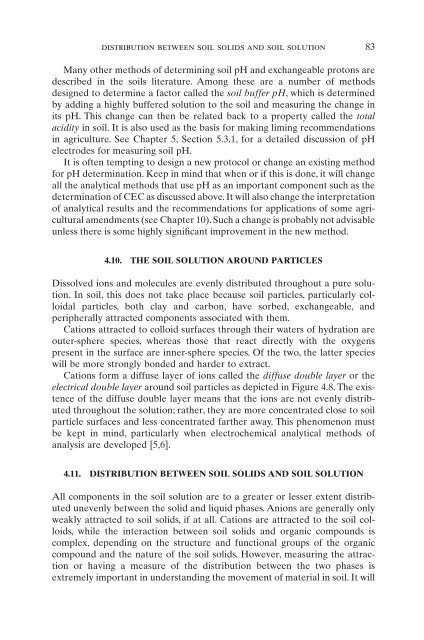Introduction to Soil Chemistry
Introduction to Soil Chemistry
Introduction to Soil Chemistry
Create successful ePaper yourself
Turn your PDF publications into a flip-book with our unique Google optimized e-Paper software.
distribution between soil solids and soil solution 83<br />
Many other methods of determining soil pH and exchangeable pro<strong>to</strong>ns are<br />
described in the soils literature. Among these are a number of methods<br />
designed <strong>to</strong> determine a fac<strong>to</strong>r called the soil buffer pH, which is determined<br />
by adding a highly buffered solution <strong>to</strong> the soil and measuring the change in<br />
its pH. This change can then be related back <strong>to</strong> a property called the <strong>to</strong>tal<br />
acidity in soil. It is also used as the basis for making liming recommendations<br />
in agriculture. See Chapter 5, Section 5.3.1, for a detailed discussion of pH<br />
electrodes for measuring soil pH.<br />
It is often tempting <strong>to</strong> design a new pro<strong>to</strong>col or change an existing method<br />
for pH determination. Keep in mind that when or if this is done, it will change<br />
all the analytical methods that use pH as an important component such as the<br />
determination of CEC as discussed above. It will also change the interpretation<br />
of analytical results and the recommendations for applications of some agricultural<br />
amendments (see Chapter 10). Such a change is probably not advisable<br />
unless there is some highly significant improvement in the new method.<br />
4.10. THE SOIL SOLUTION AROUND PARTICLES<br />
Dissolved ions and molecules are evenly distributed throughout a pure solution.<br />
In soil, this does not take place because soil particles, particularly colloidal<br />
particles, both clay and carbon, have sorbed, exchangeable, and<br />
peripherally attracted components associated with them.<br />
Cations attracted <strong>to</strong> colloid surfaces through their waters of hydration are<br />
outer-sphere species, whereas those that react directly with the oxygens<br />
present in the surface are inner-sphere species. Of the two, the latter species<br />
will be more strongly bonded and harder <strong>to</strong> extract.<br />
Cations form a diffuse layer of ions called the diffuse double layer or the<br />
electrical double layer around soil particles as depicted in Figure 4.8. The existence<br />
of the diffuse double layer means that the ions are not evenly distributed<br />
throughout the solution; rather, they are more concentrated close <strong>to</strong> soil<br />
particle surfaces and less concentrated farther away. This phenomenon must<br />
be kept in mind, particularly when electrochemical analytical methods of<br />
analysis are developed [5,6].<br />
4.11. DISTRIBUTION BETWEEN SOIL SOLIDS AND SOIL SOLUTION<br />
All components in the soil solution are <strong>to</strong> a greater or lesser extent distributed<br />
unevenly between the solid and liquid phases. Anions are generally only<br />
weakly attracted <strong>to</strong> soil solids, if at all. Cations are attracted <strong>to</strong> the soil colloids,<br />
while the interaction between soil solids and organic compounds is<br />
complex, depending on the structure and functional groups of the organic<br />
compound and the nature of the soil solids. However, measuring the attraction<br />
or having a measure of the distribution between the two phases is<br />
extremely important in understanding the movement of material in soil. It will
















